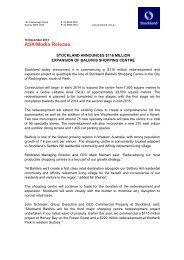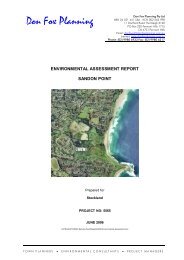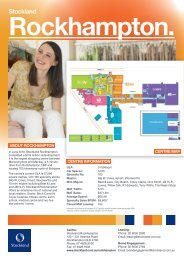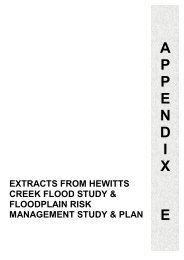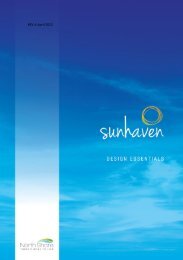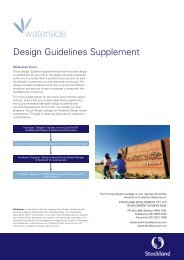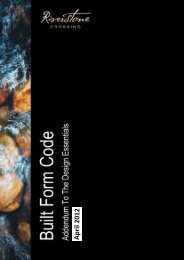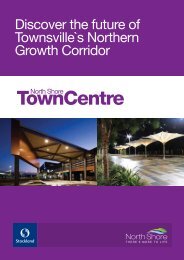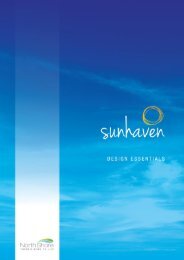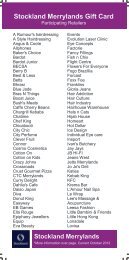SDOT2 Financial Report 30 June 2008 - Stockland
SDOT2 Financial Report 30 June 2008 - Stockland
SDOT2 Financial Report 30 June 2008 - Stockland
You also want an ePaper? Increase the reach of your titles
YUMPU automatically turns print PDFs into web optimized ePapers that Google loves.
Notes to<br />
the financial<br />
statements<br />
For the year ended <strong>30</strong> <strong>June</strong> 2007<br />
12 //<br />
2 Accounting estimates and assumptions<br />
(continued)<br />
(a) Key sources of estimation uncertainty<br />
(continued)<br />
Assumptions underlying management’s estimates<br />
of fair value<br />
The discounted cash flow approach applied for<br />
investment properties usually includes assumptions<br />
in relation to current and recent investment property<br />
prices. If such prices are not available, then the<br />
fair value of investment properties is determined<br />
using assumptions that are mainly based on market<br />
conditions existing at each balance date.<br />
The principal assumptions underlying the Responsible<br />
Entity’s estimation of fair value are those related to the<br />
receipt of contractual rentals, expected future market<br />
rentals, void periods, maintenance requirements,<br />
and appropriate discount rates. These valuations are<br />
regularly compared to actual market yield data, and<br />
actual transactions by the Trust and those reported by<br />
the market.<br />
The expected future market rentals are determined on<br />
the basis of current market rentals for similar properties<br />
in the same location and condition.<br />
i) current prices in an active market for properties of<br />
different nature, condition or location (or subject to<br />
different lease or other contracts), adjusted to reflect<br />
those differences;<br />
ii) recent prices of similar properties in less active<br />
markets, with adjustments to reflect any changes<br />
in economic conditions since the date of the<br />
transactions that occurred at those prices;<br />
iii) discounted cash flow projections based on reliable<br />
estimates of future cash flows, derived from the<br />
term of any existing lease and other contracts, and<br />
(where possible) from external evidence such as<br />
current market rents for similar properties in the<br />
same location and condition, and using discount<br />
rates that reflect current market assessments of the<br />
uncertainty in the amount and timing of cash flows;<br />
and<br />
iv) capitalised income projections based upon a<br />
property’s estimated net market income, which<br />
is assumed to be a level annuity in perpetuity,<br />
and a capitalisation rate derived from analysis of<br />
market evidence. Reversions associated with short<br />
term leasing risks/costs, incentives and capital<br />
expenditure may be deducted from the capitalised<br />
net income figure.<br />
The expected future market rentals are determined on<br />
the basis of current market rentals for similar properties<br />
in the same location and condition.<br />
It is assumed payment of the performance fee will<br />
occur in accordance with the Constitution and the<br />
projected life of the Trust.<br />
The Trust has then applied an appropriate discount rate<br />
to reflect the projected life of the fund.<br />
3 Segment reporting<br />
The Trust operates solely in the business of investment<br />
management in Australia.<br />
Estimates of performance fee expense<br />
A performance fee is payable to the Responsible Entity<br />
if certain out performance is achieved by the Trust. The<br />
fee is calculated on a sliding scale and is payable by the<br />
Trust provided the final distribution per unit exceeds the<br />
application price by 6%. The performance fee payable<br />
is based on the property net sales proceeds. The Trust<br />
has provided for a performance fee of $1,589,000 at <strong>30</strong><br />
<strong>June</strong> 2007. Refer Note 21.<br />
The Trust determines the value of the performance fee<br />
to be provided based on the current property valuation<br />
and estimates regarding the likely sales proceeds on<br />
disposal of the Trust’s property.<br />
The best evidence of the likely sales proceeds is the<br />
fair value of the property. Current prices in an active<br />
market for similar investment properties, leases and<br />
other contracts are the best indicator of fair value.<br />
Where such information is not available, the Trust<br />
determines the property’s fair value within a range<br />
of reasonable fair value estimates. In making its<br />
judgement, the Trust considers information from a<br />
variety of sources including:<br />
Assumptions underlying management’s estimates<br />
of performance fee expense<br />
The discounted cash flow approach applied for<br />
determining the fair value of the property usually<br />
includes assumptions in relation to current and recent<br />
investment property prices. If such prices are not<br />
available, then the fair value of investment properties<br />
is determined using assumptions that are mainly based<br />
on market conditions existing at each balance date.<br />
The principal assumptions underlying the Responsible<br />
Entity’s estimation of fair value are those related to the<br />
receipt of contractual rentals, expected future market<br />
rentals, void periods, maintenance requirements,<br />
and appropriate discount rates. These valuations are<br />
regularly compared to actual market yield data, and<br />
actual transactions by the Trust and those reported by<br />
the market.<br />
<strong>Stockland</strong> Direct Office Trust No.2 <strong>June</strong> 2007



